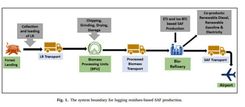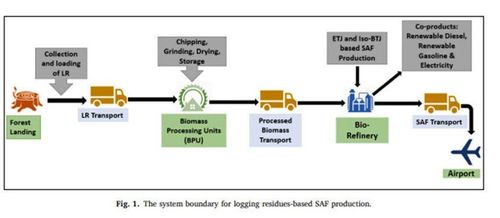Study suggests more cost-efficient, carbon friendly method for SAF production



This flow chart depicts sustainable aviation fuel production, beginning with collecting logging residue, processing, and transporting the fuel to the airport. (Graphic first published in Elsevier) / SOURCE: University of Georgia
August 6, 2024
BY University of Georgia
Biofuel generated from logging residues could make switching to sustainable aviation fuel (SAF) more cost-efficient and carbon friendly than previously thought, according to new research from the University of Georgia.
In a recent journal article Puneet Dwivedi, a professor of sustainability sciences in the Warnell School of Forestry and Natural Resources, proposed developing SAF from logging residues generated during forest harvests and thinning operations in Georgia, the largest forestry state in the country.
This study focuses on the environmental and economic impacts of SAF production from logging residues in Georgia. By analyzing two production methods, ethanol-to-jet (ETJ) and iso-butanol-to-jet (Iso-BTJ), the study estimates the life cycle carbon emissions and unit production costs associated with SAF.
The minimum aviation fuel selling price (MASP) for ETJ and Iso-BTJ pathways, after accounting for co-product revenues, was $2.71 per liter and $2.44 per liter, respectively, with capital investment at biorefineries, biomass transportation, and variable production costs being the main cost drivers. Dwivedi suggests once government subsidies like the Inflation Reduction Act of 2022 and the Renewable Identification Number credit are considered, the MASP could drop to between $2.29 and $0.83 per liter for ETJ and between $2.04 and $0.59 per liter for Iso-BTJ.
Advertisement
Conventional aviation fuel makes up about 2-3% of all carbon emissions in the United States, Dwivedi said.
“Every industry—like steel, cement, automobiles, etc.—is trying to reduce their carbon footprint,” he said. “However, it’s easier to decarbonize on land than the air.”
Due to their size and weight, airplanes and other aircraft can’t use batteries. Scientists and air industries, however, have been considering switching to a form of biofuel for quite some time, even considering vegetable oil as a potential source.
Several factors play into the costs of biofuel production, including the construction of production facilities and transporting the materials.
Advertisement
The carbon emissions for ETJ and Iso-BTJ fuels are 758 and 976 grams of CO2 (carbon dioxide) per liter, respectively, which means they produce 70.6% and 62.1% less carbon compared to regular aviation fuel. While using logging residues for SAF can greatly lower the aviation industry’s carbon emissions, government support is needed to help reduce the higher production costs and encourage wider use.
Most logging operations in Georgia take place on private land in partnerships between landowners and companies. Dwivedi noted the environmental concern of cutting down trees, but he pointed out that after the trees are harvested, the landowners would replant the harvested area for starting the next round of forest management.
With a large forestry base and home to Hartsfield Jackson Airport, the busiest airport in the world, Georgia could be the perfect place to begin SAF operations, Dwivedi said.
Published in Elsevier, the paper “Life cycle emissions and unit production cost of sustainable aviation fuel from logging residues in Georgia, United States” was co-authored by Hosne Ara Akter and Farhad Hossain Masum, also of Warnell School.
Related Stories
Saipem has been awarded an EPC contract by Enilive for the expansion of the company’s biorefinery in Porto Marghera, near Venice. The project will boost total nameplate capacity and enable the production of SAF.
Scientists at ORNL have developed a first-ever method of detecting ribonucleic acid, or RNA, inside plant cells using a technique that results in a visible fluorescent signal. The technology could help develop hardier bioenergy and food crops.
International Air Transport Association has announced the release of the Sustainable Aviation Fuel (SAF) Matchmaker platform, to facilitate SAF procurement between airlines and SAF producers by matching requests for SAF supply with offers.
Alfanar on June 20 officially opened its new office in London, further reaffirming its continued investment in the U.K. The company is developing Lighthouse Green Fuels, a U.K.-based SAF project that is expected to be complete in 2029.
ATR and French SAF aggregator ATOBA Energy on June 19 signed a memorandum of understanding (MOU) to explore ways to facilitate and accelerate sustainable aviation fuel (SAF) adoption for ATR operators.
Upcoming Events










